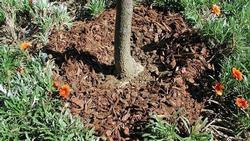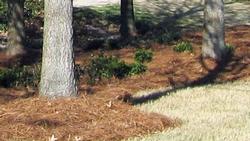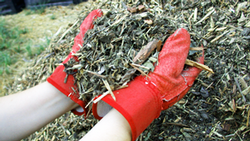Applying Mulch: Where, When & How
⟩Where to use mulch
⟩What to use
⟩When and how often to apply
⟩How much do I need
⟩How to apply
⟩Watch out for these
Where to Use Mulch
Mulches can be used in any location where soil is exposed:
• Flower or vegetable beds
• Areas around trees
• Walkways, driveways, and play and natural areas

• Keep mulch 6 to 12 inches away from the base of trees and shrubs; allow the root flare (where the trunk meets the soil) to show.
• Mulch to the outermost edge of the tree's canopy, referred to as the “drip line.”
• Keep organic mulch, except compost, five feet or more away from the home and all structural foundations; consider a band of inorganic mulch against the foundation to deter termites and other pests.
• Non-combustible rock, gravel, concrete, and pavers should be used for areas less than five feet away from structures.
Deciding what to use

• Appearance
• Size of the area
• Cost and availability
• Pros and cons of organic vs inorganic mulches
• Whether it will improve the soil
• How quickly it breaks down
• Whether it requires additional nitrogen
• Possible flammability
This chart includes information on the decomposition rate, permeability, and water retention of some common mulch materials.
For more information on the flammability of specific materials see our fire-smart mulch guidelines.
When and how often to apply

Reapply or refresh organic mulches after they have begun to break down:
Grass clippings and leaves decompose very fast and need to be replenished frequently.
Pine needles and bark mulches typically last for around 2 to 4 years.
Inorganic mulches such as gravel and pebbles rarely need replenishing.
Determine how much you need
The amount of mulch to apply depends on the texture and density of the mulch material.
To calculate how many cubic feet of mulch is needed:
1. Determine the surface area to be covered in square feet, and the desired depth of coverage.
2. Mulch is often available in bulk, measured in cubic yards.
3. Calculate the volume required by:
- multiplying area (in square feet) X depth (in feet, not inches) and
- dividing by 27 (there are 27 cubic feet in a cubic yard).
How much will one cubic yard cover?
How to apply
Before applying mulch, remove weeds and water thoroughly. Most applications of mulch are done by hand to ensure good placement.
